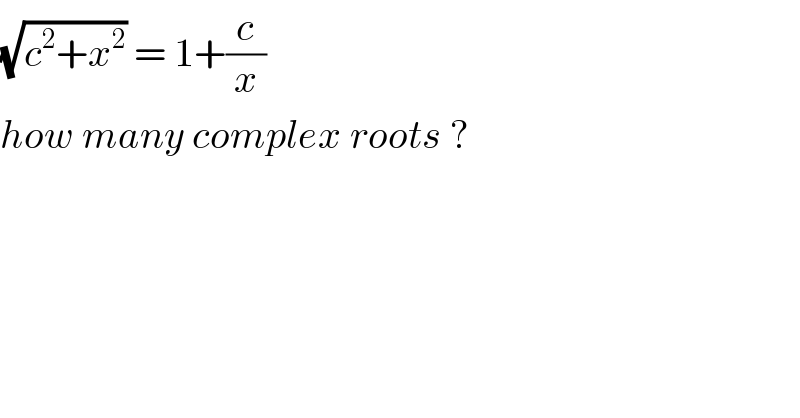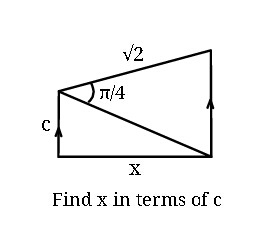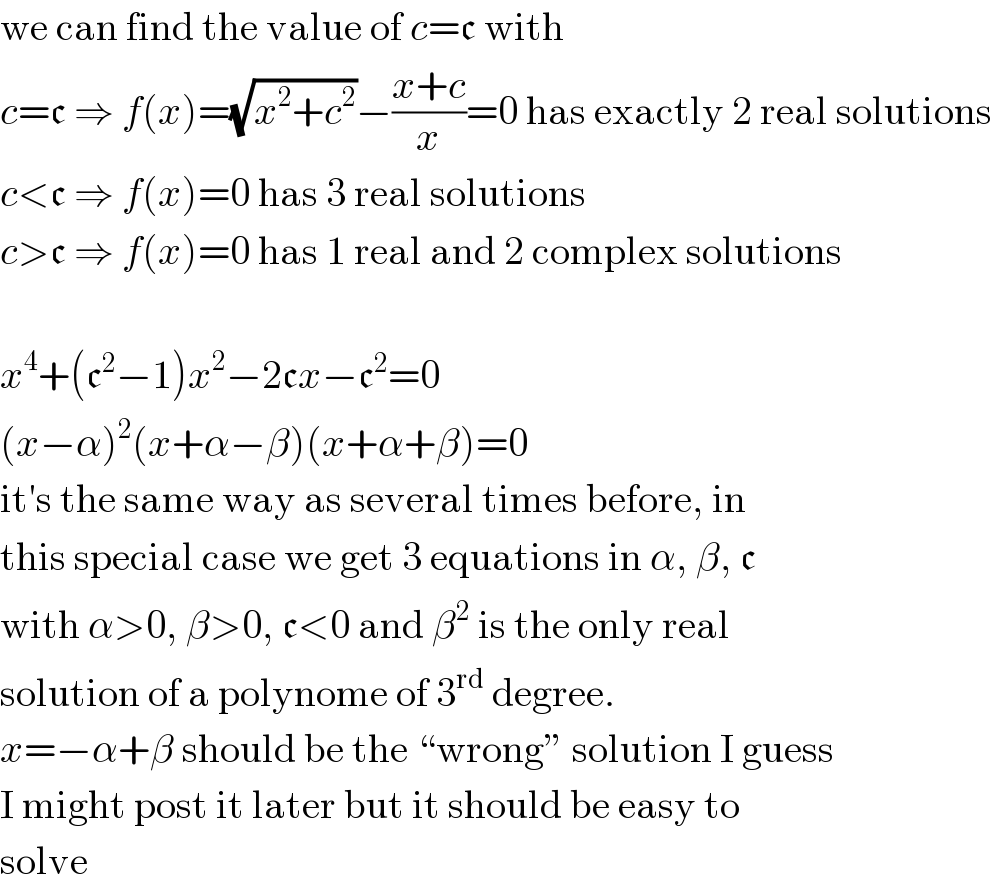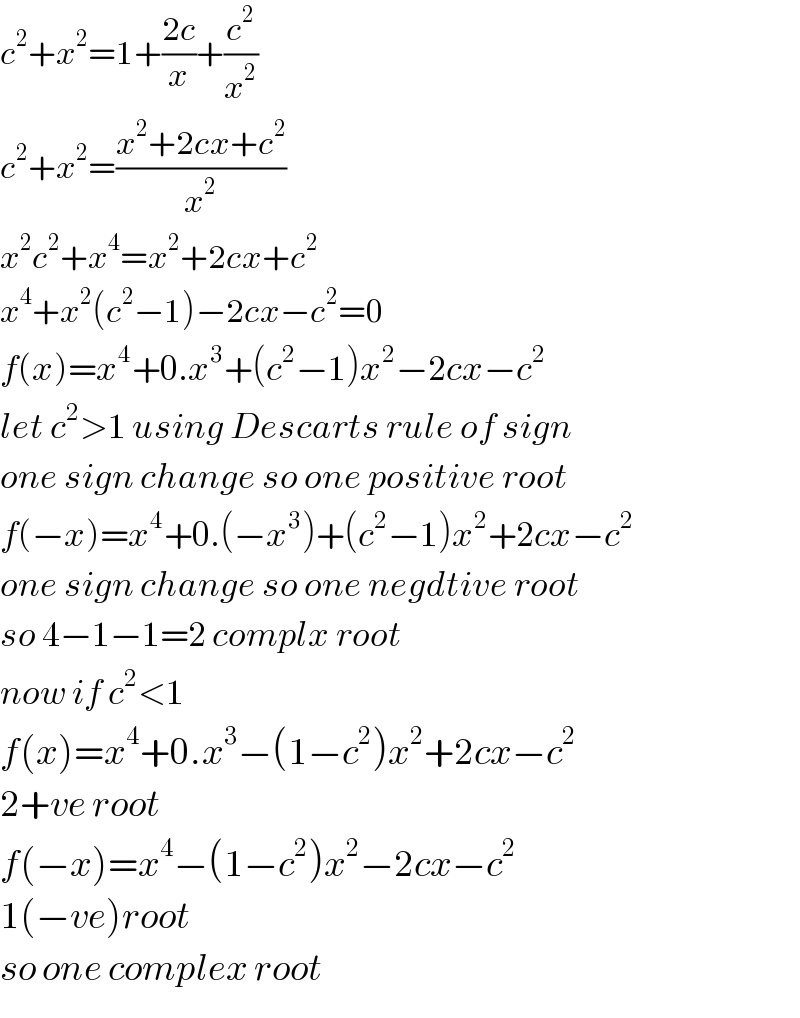Question Number 38907 by ajfour last updated on 01/Jul/18

$$\sqrt{{c}^{\mathrm{2}} +{x}^{\mathrm{2}} }\:=\:\mathrm{1}+\frac{{c}}{{x}} \\ $$$${how}\:{many}\:{complex}\:{roots}\:? \\ $$
Commented by ajfour last updated on 01/Jul/18

Commented by MJS last updated on 01/Jul/18

$$\sqrt{{c}^{\mathrm{2}} +{x}^{\mathrm{2}} }=\frac{{c}+{x}}{{x}}\:\mathrm{has}\:\mathrm{only}\:\mathrm{3}\:\mathrm{roots}.\:\mathrm{if}\:\mathrm{you}\:\mathrm{square} \\ $$$$\mathrm{to}\:\mathrm{solve}\:\mathrm{it},\:\mathrm{you}\:\mathrm{get}\:\mathrm{4}\:\mathrm{roots}\:\mathrm{of}\:\mathrm{which}\:\mathrm{one}\:\mathrm{is}\:\mathrm{no} \\ $$$$\mathrm{solution}\:\mathrm{of}\:\mathrm{the}\:\mathrm{original}\:\mathrm{equation} \\ $$
Commented by MrW3 last updated on 01/Jul/18

$${You}'{re}\:{right}\:{sir}.\:{So}\:{the}\:{answer}\:{is}: \\ $$$${depending}\:{on}\:{the}\:{value}\:{of}\:{c},\:{the} \\ $$$${original}\:{eqn}.\:{has}\:{either}\:{none}\:{or}\:{two} \\ $$$${complex}\:{roots}. \\ $$
Commented by ajfour last updated on 01/Jul/18

$${Thanks}\:{for}\:{the}\:{truth},\:{sir}. \\ $$
Commented by MJS last updated on 01/Jul/18

$$\mathrm{we}\:\mathrm{can}\:\mathrm{find}\:\mathrm{the}\:\mathrm{value}\:\mathrm{of}\:{c}=\mathfrak{c}\:\mathrm{with} \\ $$$${c}=\mathfrak{c}\:\Rightarrow\:{f}\left({x}\right)=\sqrt{{x}^{\mathrm{2}} +{c}^{\mathrm{2}} }−\frac{{x}+{c}}{{x}}=\mathrm{0}\:\mathrm{has}\:\mathrm{exactly}\:\mathrm{2}\:\mathrm{real}\:\mathrm{solutions} \\ $$$${c}<\mathfrak{c}\:\Rightarrow\:{f}\left({x}\right)=\mathrm{0}\:\mathrm{has}\:\mathrm{3}\:\mathrm{real}\:\mathrm{solutions} \\ $$$${c}>\mathfrak{c}\:\Rightarrow\:{f}\left({x}\right)=\mathrm{0}\:\mathrm{has}\:\mathrm{1}\:\mathrm{real}\:\mathrm{and}\:\mathrm{2}\:\mathrm{complex}\:\mathrm{solutions} \\ $$$$ \\ $$$${x}^{\mathrm{4}} +\left(\mathfrak{c}^{\mathrm{2}} −\mathrm{1}\right){x}^{\mathrm{2}} −\mathrm{2}\mathfrak{c}{x}−\mathfrak{c}^{\mathrm{2}} =\mathrm{0} \\ $$$$\left({x}−\alpha\right)^{\mathrm{2}} \left({x}+\alpha−\beta\right)\left({x}+\alpha+\beta\right)=\mathrm{0} \\ $$$$\mathrm{it}'\mathrm{s}\:\mathrm{the}\:\mathrm{same}\:\mathrm{way}\:\mathrm{as}\:\mathrm{several}\:\mathrm{times}\:\mathrm{before},\:\mathrm{in} \\ $$$$\mathrm{this}\:\mathrm{special}\:\mathrm{case}\:\mathrm{we}\:\mathrm{get}\:\mathrm{3}\:\mathrm{equations}\:\mathrm{in}\:\alpha,\:\beta,\:\mathfrak{c} \\ $$$$\mathrm{with}\:\alpha>\mathrm{0},\:\beta>\mathrm{0},\:\mathfrak{c}<\mathrm{0}\:\mathrm{and}\:\beta^{\mathrm{2}} \:\mathrm{is}\:\mathrm{the}\:\mathrm{only}\:\mathrm{real} \\ $$$$\mathrm{solution}\:\mathrm{of}\:\mathrm{a}\:\mathrm{polynome}\:\mathrm{of}\:\mathrm{3}^{\mathrm{rd}} \:\mathrm{degree}. \\ $$$${x}=−\alpha+\beta\:\mathrm{should}\:\mathrm{be}\:\mathrm{the}\:“\mathrm{wrong}''\:\mathrm{solution}\:\mathrm{I}\:\mathrm{guess} \\ $$$$\mathrm{I}\:\mathrm{might}\:\mathrm{post}\:\mathrm{it}\:\mathrm{later}\:\mathrm{but}\:\mathrm{it}\:\mathrm{should}\:\mathrm{be}\:\mathrm{easy}\:\mathrm{to} \\ $$$$\mathrm{solve} \\ $$
Answered by tanmay.chaudhury50@gmail.com last updated on 01/Jul/18

$${c}^{\mathrm{2}} +{x}^{\mathrm{2}} =\mathrm{1}+\frac{\mathrm{2}{c}}{{x}}+\frac{{c}^{\mathrm{2}} }{{x}^{\mathrm{2}} } \\ $$$${c}^{\mathrm{2}} +{x}^{\mathrm{2}} =\frac{{x}^{\mathrm{2}} +\mathrm{2}{cx}+{c}^{\mathrm{2}} }{{x}^{\mathrm{2}} } \\ $$$${x}^{\mathrm{2}} {c}^{\mathrm{2}} +{x}^{\mathrm{4}} ={x}^{\mathrm{2}} +\mathrm{2}{cx}+{c}^{\mathrm{2}} \\ $$$${x}^{\mathrm{4}} +{x}^{\mathrm{2}} \left({c}^{\mathrm{2}} −\mathrm{1}\right)−\mathrm{2}{cx}−{c}^{\mathrm{2}} =\mathrm{0} \\ $$$${f}\left({x}\right)={x}^{\mathrm{4}} +\mathrm{0}.{x}^{\mathrm{3}} +\left({c}^{\mathrm{2}} −\mathrm{1}\right){x}^{\mathrm{2}} −\mathrm{2}{cx}−{c}^{\mathrm{2}} \\ $$$${let}\:{c}^{\mathrm{2}} >\mathrm{1}\:{using}\:{Descarts}\:{rule}\:{of}\:{sign} \\ $$$${one}\:{sign}\:{change}\:{so}\:{one}\:{positive}\:{root} \\ $$$${f}\left(−{x}\right)={x}^{\mathrm{4}} +\mathrm{0}.\left(−{x}^{\mathrm{3}} \right)+\left({c}^{\mathrm{2}} −\mathrm{1}\right){x}^{\mathrm{2}} +\mathrm{2}{cx}−{c}^{\mathrm{2}} \\ $$$${one}\:{sign}\:{change}\:{so}\:{one}\:{negdtive}\:{root} \\ $$$${so}\:\mathrm{4}−\mathrm{1}−\mathrm{1}=\mathrm{2}\:{complx}\:{root} \\ $$$${now}\:{if}\:{c}^{\mathrm{2}} <\mathrm{1} \\ $$$${f}\left({x}\right)={x}^{\mathrm{4}} +\mathrm{0}.{x}^{\mathrm{3}} −\left(\mathrm{1}−{c}^{\mathrm{2}} \right){x}^{\mathrm{2}} +\mathrm{2}{cx}−{c}^{\mathrm{2}} \\ $$$$\mathrm{2}+{ve}\:{root} \\ $$$${f}\left(−{x}\right)={x}^{\mathrm{4}} −\left(\mathrm{1}−{c}^{\mathrm{2}} \right){x}^{\mathrm{2}} −\mathrm{2}{cx}−{c}^{\mathrm{2}} \\ $$$$\mathrm{1}\left(−{ve}\right){root} \\ $$$${so}\:{one}\:{complex}\:{root} \\ $$
Commented by ajfour last updated on 01/Jul/18

$${Thank}\:{you}\:{very}\:{much},\:{Sir}\:{Tanmay}. \\ $$
